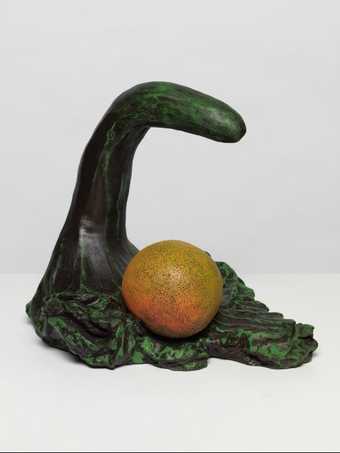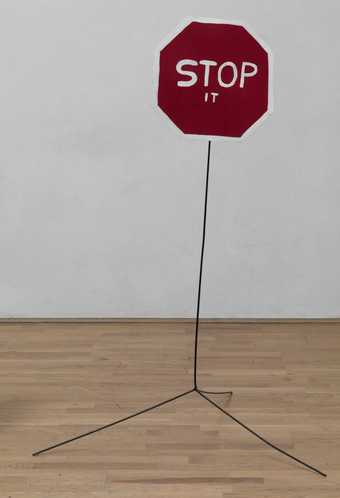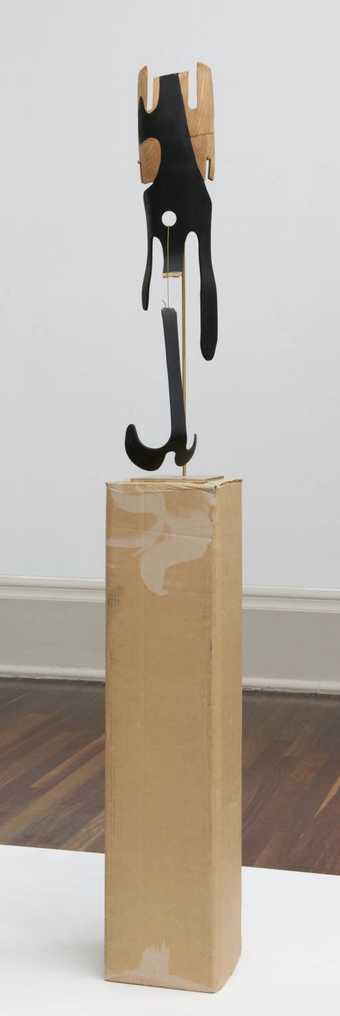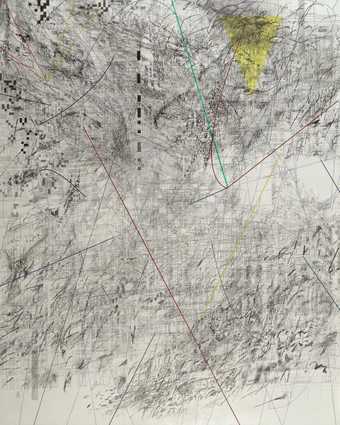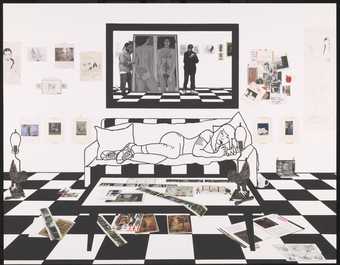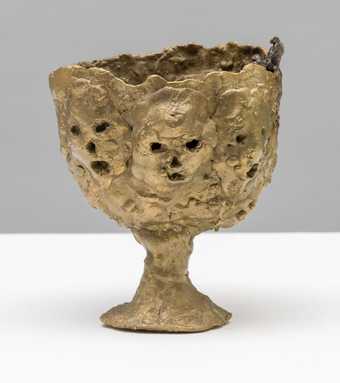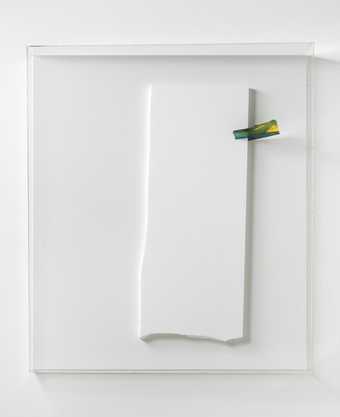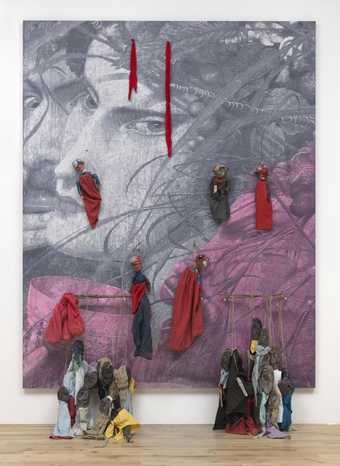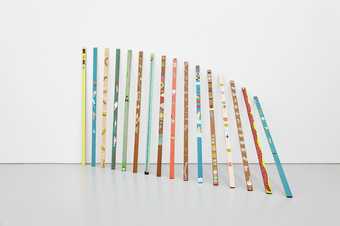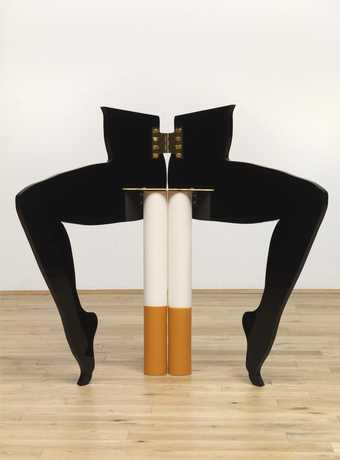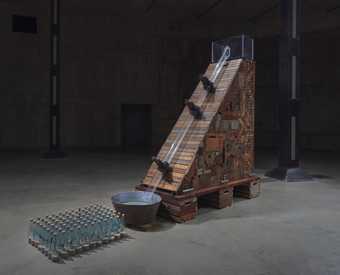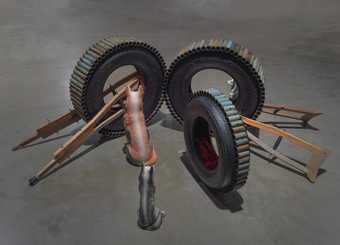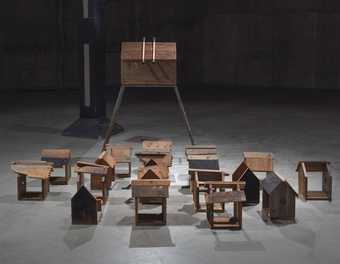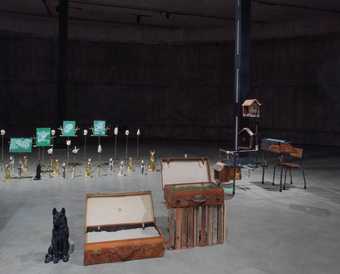Not on display
- Artist
- Lubaina Himid CBE RA born 1954
- Medium
- Acrylic paint, wooden drawer and brass handles
- Dimensions
- Object: 468 × 390 × 202 mm
- Collection
- Tate
- Acquisition
- Purchased with funds provided by the Denise Coates Foundation on the occasion of the 2018 centenary of women gaining the right to vote in Britain 2019
- Reference
- T15155
Summary
Man in A Shirt Drawer 2017–18 is a portrait of a person painted on the inside lower panel of an antique wooden shirt drawer with gold handles. The unidentified subject is of African descent and wears short cropped black hair, a pale blue blazer and an orange undershirt. Although the title refers to the figure as a ‘Man’, the depiction appears to present an androgynous figure: one can detect pale pink lipstick as well as a bright yellow eyeshadow whose hue matches the background colour. Set against this bright yellow background, the subject’s colourful outfit appears aligned with contemporary fashion and situates the scene in recent history. However, this characterisation contrasts visually with the time-period suggested by the aged, scuffed and paint-splattered drawer. In its remixing of gender and time, Man in A Shirt Drawer suggests an otherworldly and queer character that interrogates historical representations of the people of the African diaspora, an ongoing theme in the artist’s work.
Man in A Shirt Drawer is affixed to the gallery wall at eye-level on its side, so that the drawer projects at right angles to the wall. It was first displayed in Himid’s solo exhibition The Tenderness Only We Can See at Hollybush Gardens in London in 2018, positioned to face the back of the gallery so the viewer needed to walk around the object to see the painting. The work is part of an ongoing strand in Himid’s recent practice to paint figures on recycled wooden materials, such as furniture and musical instruments (see also Drowned Orchard: Secret Boatyard 2014, Tate T15156, in which sixteen separate wooden planks are used as the supports for paintings). This method can be seen as a technical extension of her earlier cut-out figures (such as The Carrot Piece 1985, Tate T14192, and Freedom and Change 1985, Tate T15264), which themselves recall the influence of Himid’s early training as a stage designer.
Further reading
Gilane Tawadros, ‘Beyond the Boundary: The work of Three Black Women Artists in Britain’, Third Text, vol.3, issue 8–9, 1989, pp.121–150.
Lubaina Himid, in conversation with Jane Beckett, ‘Diasporic Unwrappings’, in Marion Arnold and Marsha Meskimmon (eds.), Women, The Arts and Globalization: Eccentric Experience, London 2013, pp.190–222.
Jessica Morgan, Burning Down the House, exhibition catalogue, Gwangju Biennale 2014, p.83.
Griselda Pollock, ‘“How the political world crashes in on my personal everyday”: Lubaina Himid’s Conversations and Voices: Towards an Essay about Cotton.com’, Afterall: A Journal of Art, Context and Enquiry, no.43, 2017, pp.18–29.
Laura Castagnini
April 2018
Does this text contain inaccurate information or language that you feel we should improve or change? We would like to hear from you.
You might like
-
Erika Verzutti Tarsila with Orange
2011 -
David Shrigley OBE Stop It
2007 -
Martin Boyce Untitled
2009 -
Julie Mehretu Mogamma, A Painting in Four Parts: Part 3
2012 -
Frances Stark Behold Man!
2013 -
Evgeny Antufiev Untitled
2015 -
Thilo Heinzmann O.T.
2017 -
Monster Chetwynd Jesus and Barabbas (Odd Man Out 2011)
2018 -
Lubaina Himid CBE RA Drowned Orchard: Secret Boatyard
2014 -
Anthea Hamilton Leg Chair (Cigarettes)
2014 -
Kemang Wa Lehulere I cut my skin to liberate the splinter: Act 1
2017 -
Kemang Wa Lehulere I cut my skin to liberate the splinter: Act 2
2017 -
Kemang Wa Lehulere I cut my skin to liberate the splinter: Act 3
2017 -
Kemang Wa Lehulere I cut my skin to liberate the splinter: Act 4
2017 -
Kemang Wa Lehulere I cut my skin to liberate the splinter: Act 5
2017


